Heitjans P., Karger J. (Eds.). Diffusion in Condensed Matter: Methods, Materials, Models
Подождите немного. Документ загружается.

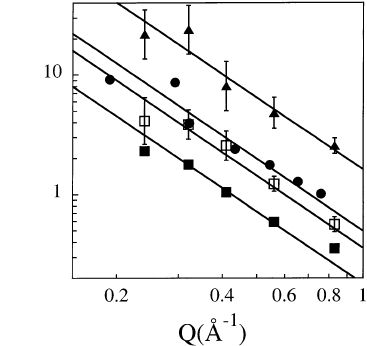
13 Viscoelasticity and Microscopic Motion in Dense Polymer Systems 529
KWW
[ (ns) ]
Fig. 13.11. Momentum transfer dependence of the characteristic time of the α-
relaxation for the polymers investigated: PVE at 340 K (), PIB at 365 K (•), PB at
280 K () and PI at 340 K (): (τ
KWW
)
β
as a function of Q in a double logarithmic
plot. Solid lines represent the Q-dependence expected in the homogenous scenario
[τ
KWW
]
β
∼ Q
2
.
behind the β-relaxation was obtained. The results suggest intrachain mo-
tions like rotations of the chain building blocks (cis and trans units) within
one chain. At temperatures around and above T
m
the NSE results qualified
the α-relaxation as being mainly related to interchain motions. The dynamic
structure factor, thereby, can consistently be described assuming that α-and
β-relaxations in 1,4 PB are statistically independent processes.
The self-correlation function measured on protonated samples reveals the
mean squared displacement of the moving hydrogens. The Q-dependence
of the characteristic relaxation time shows that motions underlying the
α-relaxation at least on a time scale larger than that of the dielectric
α-relaxation (corresponding to typically τ
KWW
(1
˚
A
−1
)) are following a
Gaussian process and are homogenous in nature.
13.4 Entropic Forces – The Rouse Model
We now turn to longer length scales, where motions resulting from local
chain potentials have already taken place, assume that the chains do not
interfere with each other in their motion and consider a Gaussian chain in a
heat bath as the simplest model for chain relaxation. The elements of such
a Gaussian chain are the so-called Kuhn segments, which consist of a few
monomers, so that their end-to-end distance follows a Gaussian distribution.
Their conformations are described by vectors a
n
along the chain. The chain
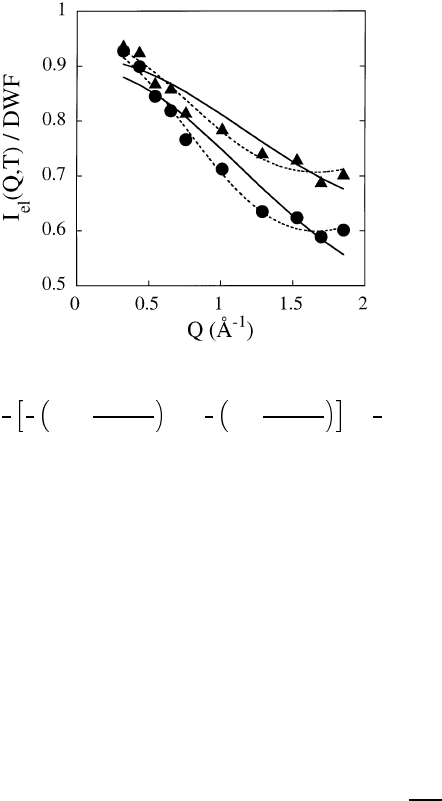
530 Dieter Richter
Fig. 13.12. Elastic incoherent intensities from PIB at 260 K () and 280 K
(•). The solid lines represent the prediction for methyl group rotation I
el
=
3
4
1
3
1+2
sin Qr
HH
Qr
HH
+ A
2
3
1 −
sin Qr
HH
Qr
HH
+
1
4
with r
HH
=0.178 nm and A re-
lates to the jump time distribution function (see [4]). The dashed line gives the fit
result for a two-site jump model with d =0.27 nm.
is then described by a sequence of freely connected segments of length .We
are interested in the motion of these segments on a length scale <r<R
E
.
This motion is described by a Langevin equation
ζ
0
˙
a
n
+ ∇
n
· F {a
i
} = f
n
(t) (13.13)
where ζ
o
is the friction coefficient, f
n
the stochastic force acting on the
segment n of extension a
n
and F the free energy. For segment motion,
the force ∇
n
F {a
i
} is dominated by the entropic part of the free energy
(S = k ln Prob{a
i
}), where
Prob{ a
i
}∼
N
/
i=1
exp
−
3a
2
i
2
2
(13.14)
is the probability of a chain conformation {a
i
}. We ascertain that the re-
sultant entropic force is a special property of macromolecular systems with
a large number of internal degrees of freedom. This conformational entropy
generates the force stabilizing the most probable conformation. As already
mentioned above, it is also the basis for rubber elasticity.
The Rouse equation of motion (cf. (13.13)) is solved by a spectrum of
normal modes. These solutions are similar to the transverse vibrational modes
of a linear chain except that relaxations are involved instead of periodic
vibrations. We obtain for the relaxation rates

13 Viscoelasticity and Microscopic Motion in Dense Polymer Systems 531
1
τ
p
=
3π
2
k
B
T
ζ
0
N
2
2
p
2
(13.15)
where N denotes the chain length. The mode index p counts the number
of nodes along the chain. The relaxation rate is proportional to the number
of nodes to the second power. On the basis of these normal modes we can
calculate the dynamic structure factor S(Q, t). This will be done later on.
Here, an asymptotic solution for long chains will be briefly dealt with. It was
formulated by de Gennes [40], who finds for the characteristic relaxation rate
Ω
Ω =
1
12
k
B
T
ζ
0
2
Q
4
. (13.16)
Unlike diffusion, where the characteristic relaxation rate is proportional to
the momentum transfer Q
2
, the fourth power is found here. Another char-
acteristic quantity of diffusive motions is the mean square displacement of a
segment. For Rouse motion follows
(r(0) − r(t))
2
∼t
1/2
(13.17)
which, again, is in clear contrast to normal diffusion where a linear time law
holds. In Fig. 10.19 of Chap. 10 patterns of PFG NMR results for polymer
diffusion are presented which follow the dependence of (13.17), though they
do not relate to Rouse motion. The Rouse equation (13.13) applies to a
length domain which is greater than the segment length and which is limited
upwards by the entanglement distance. In this domain, no further length
scale appears. The dynamic structure factor therefore assumes a scaling form
linking length and time scales.
S(Q, t)=f(Q
2
2
√
Wt) (13.18)
with the Rouse rate W =3k
B
T/(ζ
0
/l
2
).
13.4.1 Neutron Spin-Echo Results in PDMS Melts
In order to study the Rouse dynamics, a polymer with a low plateau modu-
lus is needed, i.e. few entanglements and high flexibility and mobility. Poly-
dimethylsiloxane (PDMS) fulfils these conditions. Neutron spin-echo exper-
iments were carried out for both the self-correlation function and the pair-
correlation function in PDMS melts.
Neutron measurements of the self-correlation function are normally per-
formed on protonated materials since then the incoherent scattering is
strongly dominating. Due to spin flip scattering, which leads to a loss of
polarization, this approach is difficult for the NSE method. In order to avoid
this obstacle, high-molecular-weight deuterated PDMS containing short pro-
tonated labels at random positions was synthesized. Each of these protonated
sequences contained eight monomers. In such a specimen, scattering is mainly
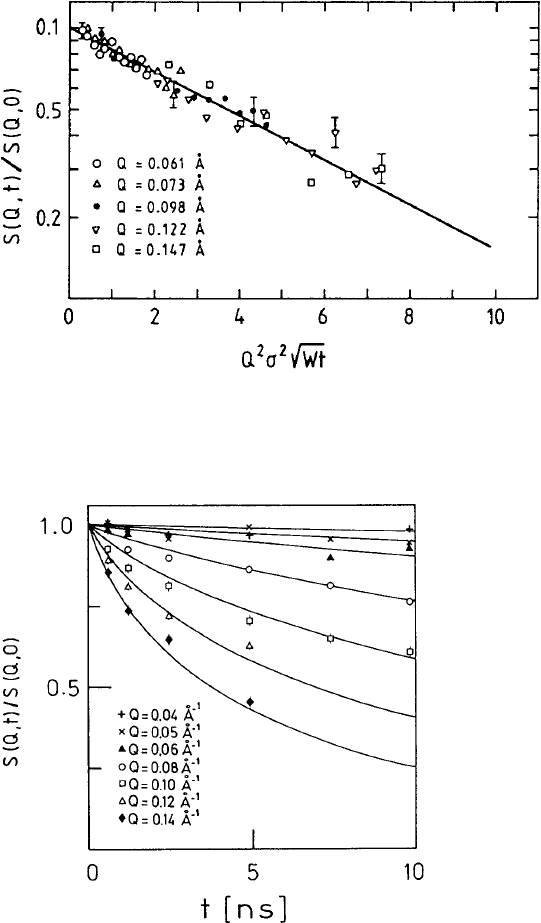
532 Dieter Richter
Fig. 13.13. NSE spectra for the self-correlation function measured in a randomly
labelled PDMS melt at 100
◦
C. The data are scaled with the Rouse variable (σ
2
≡
l
2
). The solid line is the result of a fit with the Rouse self-correlation function.
Fig. 13.14. NSE spectra for the pair-correlation function in PDMS melts at 200
◦
C.
The solid lines are the result of a fit with the coherent structure factor calculated
by de Gennes (see text).
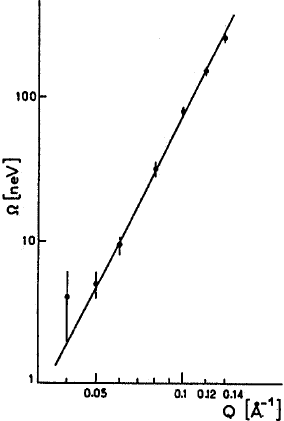
13 Viscoelasticity and Microscopic Motion in Dense Polymer Systems 533
Fig. 13.15. Dependence of the charac-
teristic relaxation rate Ω as a function
of the momentum transfer Q resulting
from an analysis of the spectra shown
in Fig. 13.14. The solid lines denotes the
predicted Ω ∼ Q
4
dependence.
caused by the contrast between the protonated sequence and the deuterated
environment and is therefore coherent. On the other hand, the sequences are
randomly distributed, so that there is no constructive interference of par-
tial waves from different sequences. The scattering experiment measures the
self-correlation function under these conditions [5].
In Fig. 13.13 the scattering data are plotted versus the scaling variable of
the Rouse model (cf. (13.18)). The results for different momentum transfers
follow a common straight line. For the case of the self-correlation function, the
scattering function directly measures the mean square displacement which,
according to (13.17), follows a square root law in time. This behaviour can be
directly read from Fig. 13.13 (For data from polyethylene propylene (PEP)
see also [41]).
The pair-correlation function for segment dynamics of a chain is observed
if some protonated chains are dissolved in a deuterated matrix. The scat-
tering experiment then observes the result of the interfering partial waves
originating from such a chain (cf. (13.1)). Figure 13.14 presents the dynamic
structure factor of a deuterated melt with 5% protonated chains. The solid
lines represent a fit with (13.18) [12]. Obviously, the structure factor calcu-
lated by de Gennes satisfactorily describes the neutron data (the only fit
parameter W
4
=3k
B
T
2
/ζ
0
). Figure 13.15 presents the characteristic relax-
ation rate Ω as a function of momentum transfer Q. The data are in very
good agreement with the predicted Q
4
law.
The microscopic Rouse relaxation rate W also determines the viscosity of
the non-entangled melt
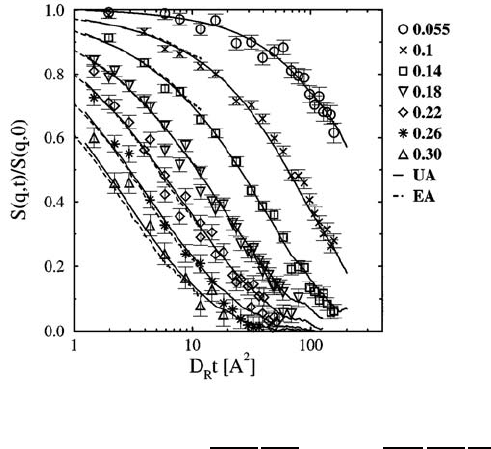
534 Dieter Richter
Fig. 13.16. NSE data
from PE melts vs.
computer simulations
using the EA and UA
models for different
Q(≡ q)values/
˚
A
−1
.
η =
ρN
A
NM
0
k
B
T
2
p
τ
p
=
ρN
A
M
0
k
B
T
12
N
W
(13.19)
where ρ is the polymer density and N
A
the Avogadro constant. Measured
viscosities and calculated viscosities using the microscopically determined
rate W are in agreement within 20%.
13.4.2 Computer Simulations
In order to learn about the limits of the Rouse model, recently a detailed
quantitative comparison of molecular dynamics (MD, cf. also Chap. 23) com-
puter simulations on a 100 C-atom polyethylene chain (PE) with NSE exper-
iments on PE chains of similar molecular weight has been performed [17].
Both the experiment and the simulation were carried out at T = 509 K. Sim-
ulations were undertaken for an explicit (EA) as well as for a united (UA)
atom model. In the latter the H atoms are not explicitly taken into account
but reinserted when calculating the dynamic structure factor. The potential
parameters for the MD simulation were either based on quantum chemical
calculations or taken from literature. No adjusting parameter was introduced.
Figure 13.16 compares the results from the MD-simulation (solid and broken
lines) with the NSE spectra. In order to correct for the slightly different over-
all time scales of experiment and simulation, the time axis is scaled with the
center-of-mass diffusion coefficient. From Fig. 13.16 quantitative agreement
between both results is evident.
Figure 13.17 compares the same experimental data, which agreed quan-
titatively with the simulations, with a best fit to the Rouse model (see [17]).
Here a good description is observed for small Q-values (Q ≤ 0.14
˚
A
−1
), while
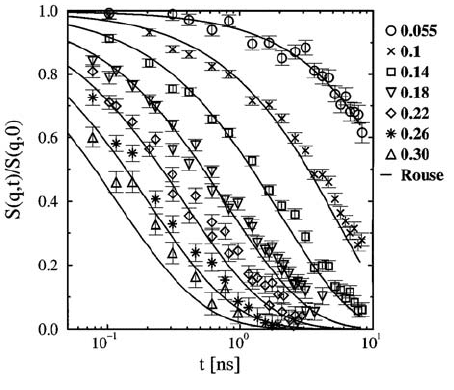
13 Viscoelasticity and Microscopic Motion in Dense Polymer Systems 535
Fig. 13.17. NSE
data from PE melts
in comparison to a
best fit with the Rouse
model for different
Q(≡ q)values/
˚
A
−1
.
at higher Q important deviations appear. Similarly also the simulations can-
not be fit in detail with a Rouse structure factor.
Having obtained very good agreement between experiment and simula-
tion, the simulations which contain complete information about the atomic
trajectories may be further exploited, in order to rationalize the origin for
the discrepancies with the Rouse model. A number of deviations evolve.
1. According to the Rouse model the mode correlators should decay in a
single-exponential fashion. A direct evaluation from the atomic trajec-
tories shows that the 3 contributing Rouse modes decay with stretched
exponentials displaying stretching exponents β of (0.96 (mode 1) and 0.86
(modes 2 and 3)).
2. A detailed scrutiny of the Gaussian assumption reveals that for t<τ
R
deviations occur.
3. While the Rouse model predicts a linear time evolution of the mean
squared centre of mass coordinate, within the time window of the simu-
lation (t<9 ns) a sublinear diffusion in form of a stretched exponential
with a stretching exponent of β =0.83 is found. A detailed inspection of
the time-dependent mean squared amplitudes reveals that the sublinear
diffusion mainly originates from motions at short times t<τ
R
=2ns.
The prediction of a time-dependent center-of-mass diffusion coefficient has
recently been corroborated by NSE-experiments on short-chain polybutadi-
enes [42]. Figure 13.18 displays the mean squared center-of-mass displacement
from simulation compared to the same quantity obtained from the dynamic
structure factor at various Q-values. Both the simulation and the experimen-
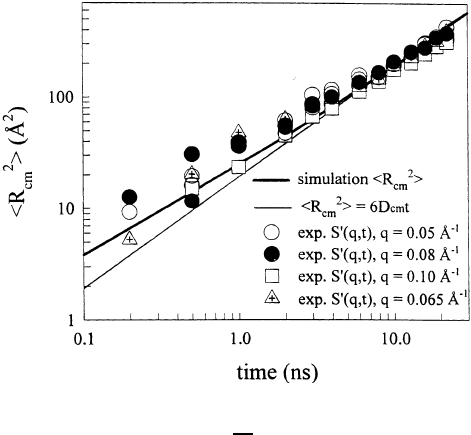
536 Dieter Richter
Fig. 13.18. Mean square center-of-mass displacement for PB chains in the melt
obtained from r
2
(t) = −
6
Q
2
nS(Q, t). Solid line: simulation result; thin line
r
2
(t) = D
R
t.
tal data consistently lead to a weaker than linear time dependence of the
center-of-mass displacement.
The overall picture emerging from this combined simulational and experi-
mental effort is, that for chains, which should be ideal Rouse chains, the model
is capable of quantitatively describing the behaviour only on time scales of
the order of the Rouse time or larger and therefore on length scales of the
order of the radius of gyration of the chains or larger and in the regime, where
the chains actually show Fickian diffusion. The self-diffusion behaviour for
times smaller than the Rouse time and the relaxation of the internal modes of
the chains show small but systematic deviations from the Rouse prediction.
The origin of these discrepancies are traced to interchain interactions. On
the other hand, we will see that deviations observed at higher Q relate to
intrachain potentials.
Let us draw a second conclusion: The chain dynamics for times, where en-
tanglement effects do not yet play a role, is excellently described by Langevin
dynamics with entropic restoring forces. The Rouse model nearly quantita-
tively describes (i) the Q-dependence of the characteristic relaxation rate,
(ii) the spectral form of both the self- and the pair-correlation function and
(iii) establishes the correct relation to macroscopic viscosity. (iv) Finally, de-
tailed comparisons with MD-simulation reveal small deviations originating
from interchain interactions.

13 Viscoelasticity and Microscopic Motion in Dense Polymer Systems 537
13.5 Long-Chains Reptation
13.5.1 Theoretical Concepts
The reptation model of de Gennes [43], Doi and Edwards [44] proceeds on the
intuitive assumption that the motions of a chain in a melt are significantly
impeded by the surrounding chains in directions lateral to its own profile. The
dominant diffusive motion, therefore, proceeds along the coarse-grained chain
profile. A chain meanders through a melt like a snake. The lateral restrictions
are modelled by a tube running parallel to the coarse-grained chain profile.
Its diameter is correlated with the plateau modulus of the melt, as discussed
in the introduction. The restriction of motion by other chains is not effective
on the monomer scale, but permits lateral motions on intermediary length
scales (d
t
∼
=50...100
˚
A). In this simple intuitive model, the experimental
observations for viscosity and diffusion can be readily made comprehensible.
According to (13.19) the viscosity is determined by the longest relaxation
time – here the abandonment of an initial configuration. Assuming that the
chain is subject to a Rouse diffusion within its tube, D
R
∝ 1/N holds for the
tube diffusion. The chain has left an initial configuration when it is diffused
over a contour length L = N .Thisgives
τ
η
∝
L
2
D
∝ N
3
∝ η. (13.20)
In space, the contour of the chain follows a Gaussian random path, i.e. the
chain diffuses over a spatial distance during the time τ
η
, which corresponds
to its end-to-end distance (R
E
∝ N
1/2
). The reptation diffusion coefficient
then reads
D
rep
∝
R
2
E
τ
η
∝
1
N
2
. (13.21)
Whereas the experimentally observed viscosity generally depends on the
molecular weight with an exponent slightly greater than 3 – there is rea-
son to suppose that an N
3
law is fulfilled for very long chain lengths – the
predicted chain length dependence of the diffusion coefficient is directly con-
firmed experimentally.
What are the consequences of the localization tube for the dynamic struc-
ture factor? For short times during which the mean squared segment displace-
ment is smaller than the tube limitation, the chain motion should proceed
without being affected by the tube restriction. In this case, the Rouse law
should apply, especially its scaling property of momentum transfer and time
(cf. (13.18)). For medium times, density fluctuations transversely to the tube
have already equilibrated. Pair correlations along the tube are stabilized by
the localization tube and are only decomposed when the chain leaves the
tube. We thus expect that the dynamic structure factor tends to a constant
dependent on Q. A further decomposition of S(Q, t) only occurs for times

538 Dieter Richter
of the order of τ
η
. The value of the Q-dependent plateau results from the
Fourier transform of the localization tube. The essential new feature in the
dynamic structure factor of the reptating chain is the appearance of a length
scale d, which invalidates the scaling property of the Rouse model.
Quantification requires analytical models, which can be compared with
the data. We would like to briefly discuss three different model categories
without explaining them in detail. (i) In so-called generalized Rouse models
[45, 46] the effect of the topological constraints is described by a memory
function. In the limiting case of long chains, in the time domain of the NSE
experiment the dynamic structure factor can be explicitly calculated in such
models. (ii) Neglecting the initial Rouse motion for small values of the Rouse
scaling variable in his local reptation model de Gennes explicitly calculated
the collective chain motion in the localization tube [47]. For the dynamic
structure factor in the limit of long times, this gives
S(Q, t)
t→∞
= S(Qd
t
; Q
2
t
1/2
)
t→∞
=1−
Q
2
d
2
t
36
. (13.22)
(iii) Des Cloizeaux finally formulated a rubber-like model for the chain motion
for intermediate times [48]. He assumed that for intermediate times the en-
tanglement points of the chains are fixed in space and that the chains perform
Rouse motions under the boundary condition of fixed entanglement points.
This rubber-like model is closest to the concept of a temporary network.
13.5.2 Experimental Observations of Chain Confinement
Figure 13.19 compares the dynamic structure factors from polyethylene
melts, both taken at 509 K for two different molecular weights [7, 8, 16, 23].
Figure 13.19a displays the structure factor for a short-chain melt (M
w
=
2000 g/mol). The solid lines display a fit with the Rouse dynamic structure
factor. Very good agreement is achieved. Figure 13.19b displays similar re-
sults from a PE melt with a molecular weight of M
w
= 12400 g/mol. The
solid lines present the predictions of the Rouse model. While for the short-
chain melts this model describes well the experimental observations, for the
longer chains the model fails completely. Only in the short-time regime the
initial decay of the dynamic structure factor is depicted, while for longer
times the relaxation behaviour is strongly retarded signifying confinement
effects. In Fig. 13.20 the data from a M
w
= 36000 PE-melt at 509 K are
plotted as a function of the scaling variable of the Rouse model (see (13.18)).
In contrast to Fig. 13.13 the scaled data do not follow a common curve, but
after an initial common course they rather split into Q-dependent branches.
This splitting is a consequence of a dynamic length scale present in the melt,
which invalidates the Rouse scaling properties. We note, that this length is
of purely dynamical character and cannot be observed in static experiments.
Figure 13.21 presents recent experimental results on a polyethylene melt
(M
w
= 190000), which were carried over a time regime of 170 ns [23]. The data
